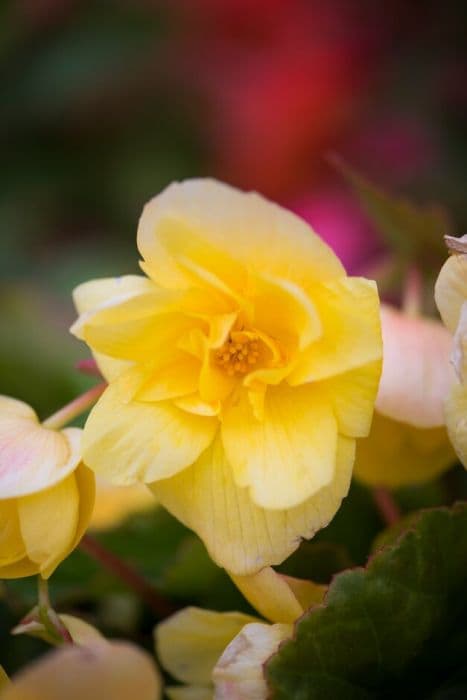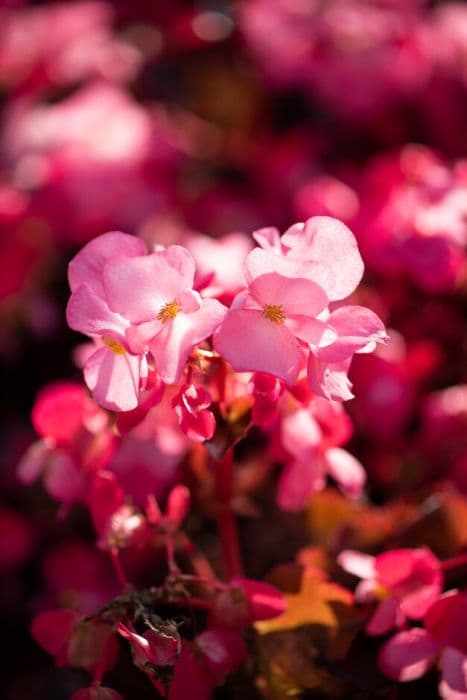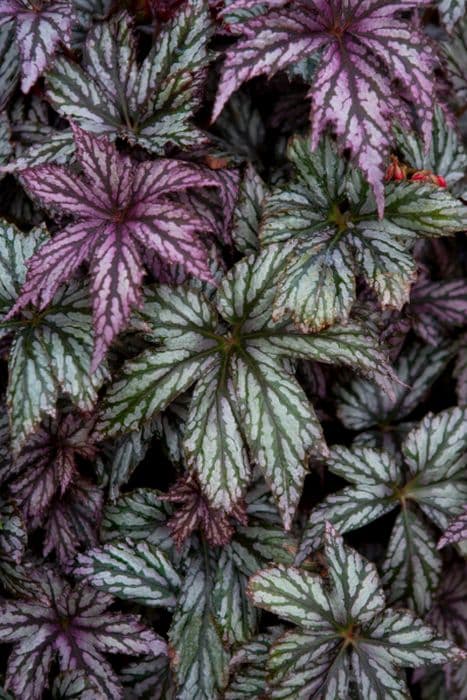Angel Wing Begonia Begonia 'Lois Burks' (C)

ABOUT
Begonia 'Lois Burks' is a striking ornamental plant known for its vibrant foliage and flowers. The leaves are the standout feature, characterized by a deep green hue with a glossy surface and prominent veins that may show a contrasting color, adding to the decorative appearance of the foliage. Edges of the leaves are often uniquely shaped, adding a ruffled or serrated texture that enhances the visual interest of the plant. This Begonia often produces abundant flowers that come in a variety of colors, such as pink, red, or white, and these blooms add a splash of color, contrasting nicely with the lush leaves. The flowers typically appear in clusters that rise above the foliage on sturdy stems, creating a layered look that is quite appealing. The overall appearance of Begonia 'Lois Burks' is lush and full, with a well-branched structure that allows the leaves and flowers to spread out and create a dense, bushy effect. As an ornamental plant, it is often admired for its ability to add a tropical touch to indoor spaces or shaded garden areas. While the size can vary with care and growing conditions, the plant's aesthetic appeal remains consistent, making it a popular choice for those wishing to add a burst of natural beauty to their surroundings.
About this plant
 Names
NamesFamily
Begoniaceae
Synonyms
Lois Burks Begonia
Common names
Begonia 'Lois Burks'
 Toxicity
ToxicityTo humans
Begonias, which include the Begonia 'Lois Burks', are known to contain oxalate crystals. If ingested, parts of this plant can cause irritation and burning sensations in the mouth, tongue, and throat. Additional symptoms may include difficulty swallowing, nausea, vomiting, and diarrhea. In severe cases, the swelling caused by the irritation can lead to difficulty breathing. Skin contact with the sap may also cause irritation or rash in sensitive individuals.
To pets
Begonias, such as the Begonia 'Lois Burks', are also toxic to pets due to the presence of insoluble oxalates. If a pet chews or ingests parts of the plant, it can lead to oral irritation, intense burning and irritation of the mouth, lips, and tongue, excessive drooling, vomiting, and difficulty swallowing. It is important to keep this plant out of reach of pets to avoid these potential symptoms.
 Characteristics
CharacteristicsLife cycle
Perennials
Foliage type
Evergreen
Color of leaves
Varies
Flower color
Pink
Height
1-2 feet (0.3-0.6 meters)
Spread
1-2 feet (0.3-0.6 meters)
Plant type
Herb
Hardiness zones
10
Native area
Central America
Benefits
 General Benefits
General Benefits- Ornamental Value: Begonias are widely appreciated for their beautiful flowers and attractive foliage, adding aesthetic appeal to gardens and indoor spaces.
- Versatility: They are suitable for a variety of settings, including flower beds, borders, containers, and hanging baskets.
- Shade Tolerance: Begonias generally thrive in shaded areas where many other plants may not perform well, allowing for color in less sunny spots.
- Long Blooming Season: Begonias offer a prolonged blooming period, often from spring to fall, providing long-lasting color and interest.
- Low Maintenance: They require minimal care beyond regular watering and occasional fertilizing, making them ideal for busy gardeners.
- Drought Resistance: Once established, many begonia varieties can tolerate brief periods of drought, adding to their low-maintenance quality.
- Easy Propagation: Begonias can be easily propagated from cuttings, enabling gardeners to create new plants for free.
 Medical Properties
Medical PropertiesThis plant is not used for medical purposes.
 Air-purifying Qualities
Air-purifying QualitiesThis plant is not specifically known for air purifying qualities.
 Other Uses
Other Uses- Photography subject: The Begonia 'Lois Burks' can serve as an excellent subject for macro photography due to its intricate patterns and vibrant colors.
- Educational tool: Biology teachers might use the Begonia to explain plant anatomy, pollination, and reproduction to students.
- Art inspiration: Artists may find the distinctive leaves and flowers of the Begonia inspirational for paintings, drawings, and textile designs.
- Bioindication: Sometimes plants like Begonia can serve as bioindicators, revealing the health of the ecosystem in which they are growing.
- Culinary decoration: Edible species of Begonias can be used to decorate cakes and pastries; however, ensure that the specific Begonia in question is safe for consumption.
- Theme gardens: Begonia enthusiasts may use the 'Lois Burks' variety as a centerpiece in a themed garden, such as a pink garden or a shade garden.
- Gift plant: Due to its beautiful appearance, a potted Begonia 'Lois Burks' makes a thoughtful gift for plant lovers on special occasions.
- Seasonal display: The Begonia can be incorporated into seasonal floral arrangements or displays, especially for spring and summer themes.
- Collectibles: Some gardeners collect different Begonia varieties, including 'Lois Burks', as part of a personal or public display collection.
- Study of hybridization: Horticulture students and enthusiasts might study this variety as an example of successful plant hybridization and breeding techniques.
Interesting Facts
 Feng Shui
Feng ShuiThe Begonia is not used in Feng Shui practice.
 Zodiac Sign Compitability
Zodiac Sign CompitabilityThe Begonia is not used in astrology practice.
 Plant Symbolism
Plant Symbolism- Caution - Begonias are often associated with a warning or to proceed carefully in some cultures, possibly due to their delicate appearance and the fact that some species can be toxic.
- Uniqueness - The cultivar 'Lois Burks' implies a certain distinctiveness, as cultivars are developed for their unique characteristics, making them stand out from other flowers.
- Harmony - Begonias can represent harmony due to their balanced and symmetrical form, suggesting a sense of stability and peace.
- Gratitude - Giving someone a begonia can be a way of expressing thankfulness or appreciation for their efforts or friendship.
 Water
WaterFor Rex Begonia, water thoroughly once the top inch of soil feels dry, typically every 7 to 10 days, depending on the environmental conditions. Provide enough water to allow some to run out of the drainage holes, indicating that the soil is fully saturated, which may be approximately 16 to 32 onzes for a standard pot size. During winter, reduce watering to prevent waterlogging as plant growth slows down, ensuring the soil remains slightly moist but not soggy.
 Light
LightRex Begonia thrives in bright, indirect light away from direct sunlight which can scorch its leaves. The best spot for this plant would be near an east or north-facing window or a location that receives filtered sunlight. A sheer curtain can be used to diffuse the intensity of direct sunlight if necessary.
 Temperature
TemperatureRex Begonia prefers temperatures between 60 and 75 degrees Fahrenheit. It can survive temporarily outside this range but sustained temperatures above 86 degrees Fahrenheit or below 50 degrees Fahrenheit can harm the plant. Ideally, maintain indoor air temperature within this range to ensure optimal growth.
 Pruning
PruningFor Rex Begonia, pruning is recommended to remove any dead or dying leaves and to promote a bushy, well-shaped plant. Prune sparingly, preferably during the growing season of spring or summer, and cut just above a leaf node to encourage new growth. This process should be done every few months or as necessary to maintain the plant's appearance.
 Cleaning
CleaningAs needed
 Soil
SoilAngel Wing Begonia prefers a well-draining soil mix composed of peat moss, pine bark, and perlite in equal parts. This combination ensures good moisture retention while preventing waterlogging. The ideal soil pH range for the Angel Wing Begonia is slightly acidic to neutral, around 5.5 to 6.5.
 Repotting
RepottingAngel Wing Begonia should be repotted every 2-3 years or when it becomes root-bound. Fresh soil replenishes nutrients and provides space for continued growth.
 Humidity & Misting
Humidity & MistingAngel Wing Begonia thrives in high humidity conditions and is best kept at a humidity level of 50-60%. This mimics its natural tropical habitat.
 Suitable locations
Suitable locationsIndoor
Place Angel Wing Begonia in bright, indirect light and maintain humidity.
Outdoor
Keep Angel Wing Begonia in shade and protect from cold drafts.
Hardiness zone
10-11 USDA
 Life cycle
Life cycleThe life of Begonia 'Lois Burks' starts as a small seed or more commonly from a piece of a leaf or stem used for propagation. Germination or root development takes place in moist, warm soil, giving rise to a new plantlet. As it matures, it begins to develop a strong root system and foliage characterized by asymmetrical, wing-like leaves. The plant then enters a vegetative state, during which it focuses on growth and can be pinched or pruned to encourage bushier growth. Flowering occurs in the right conditions, with blooms that vary in color, presenting an array of beautiful flowers that can last for several weeks. After flowering, if seeds are produced, they will ripen and can be collected for sowing, thus continuing the cycle; otherwise, the plant will prepare for a period of dormancy, especially in cooler climates, before beginning the cycle again with new growth in the next season.
 Propogation
PropogationPropogation time
Spring-Early Summer
Begonia 'Lois Burks', commonly referred to as simply Begonia, is typically propagated through stem cuttings. This popular method involves taking a healthy stem from the mother plant that includes at least one or two leaves and a few nodes where the leaves attach to the stem. To initiate propagation, the stem should be cut just below a node using a clean, sharp knife or scissors. The cut end can then be dipped in rooting hormone powder to encourage root growth, although this is not mandatory. The bottom leaves are usually removed before the stem cutting is inserted into a moist potting mix, which should be a well-draining soil mixture. The pot containing the cutting should be kept in indirect sunlight and maintained at a temperature range of about 65 to 75 degrees Fahrenheit (18 to 24 degrees Celsius). Roots typically begin to develop within a few weeks, after which the new Begonia plant can eventually be transplanted into its own pot.





![Begonia [Devotion]](/_next/image?url=https%3A%2F%2Fplants-admin.emdemapps.com%2Fimages%2Fplants%2F%2Fimages%2F604b58183573b.png&w=640&q=75)



